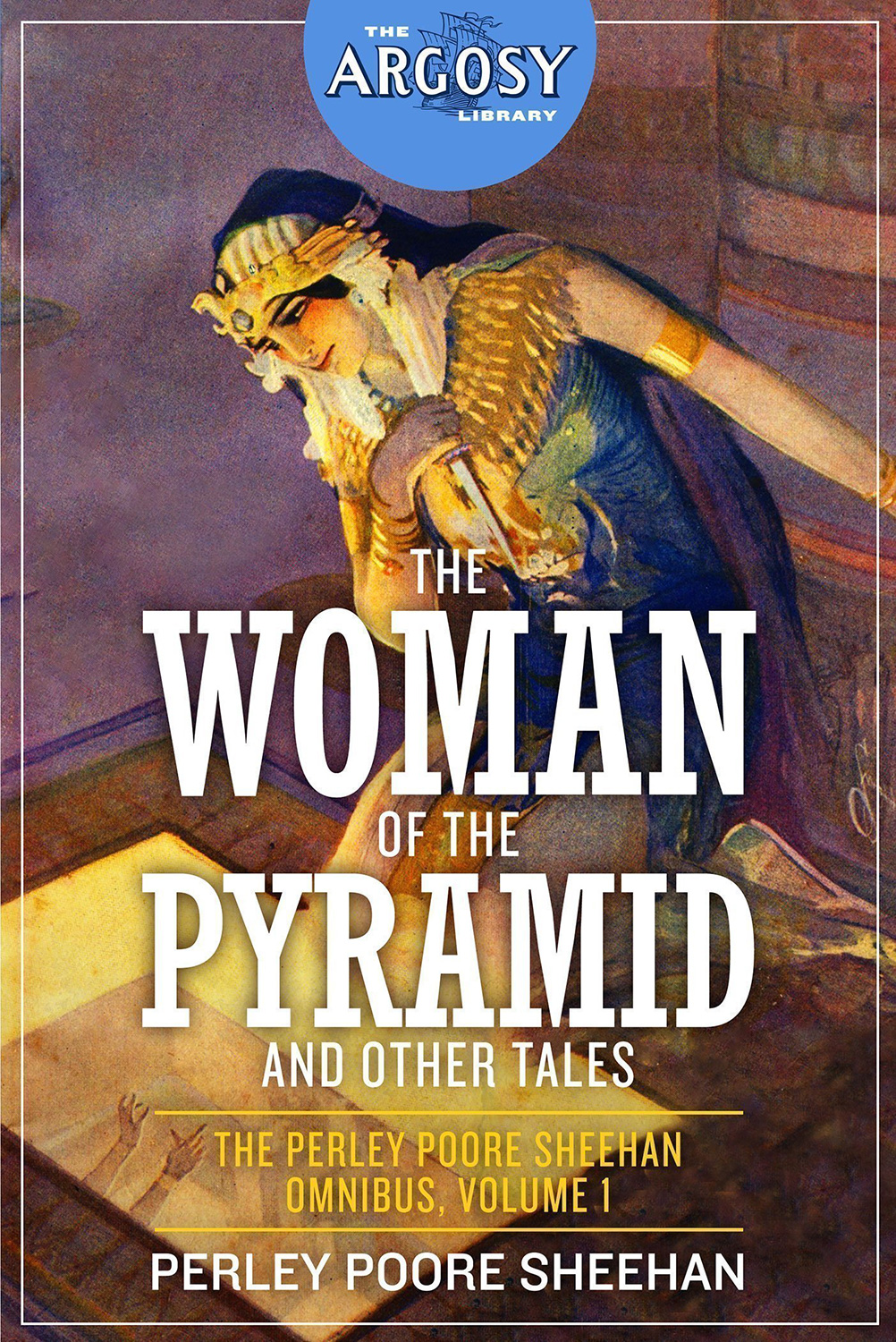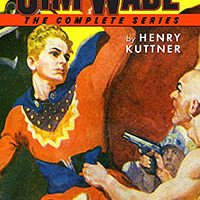 This volume — the first of I have no idea how many volumes — reprints four of his stories from All-Story and Argosy, starting with one I wanted to read, “The Woman of the Pyramid.” It’s about an Egyptologist who dreams of a woman from the past, meets her, and is somehow thrown back to ancient Egypt.
This volume — the first of I have no idea how many volumes — reprints four of his stories from All-Story and Argosy, starting with one I wanted to read, “The Woman of the Pyramid.” It’s about an Egyptologist who dreams of a woman from the past, meets her, and is somehow thrown back to ancient Egypt.
Also included are a trio of works set in Florida dealing with the Seminoles: “The Lone Seminole,” The One Gift,” and “Egrets.” Being from Florida and very familiar with the Seminoles, I am interested to see how accurate they are.
First up is “The Woman of the Pyramid.” This appeared in All-Story in 1914 and was cover featured, and is one of his earliest novels. Yes, the cover artwork was used for this collection. The novel is what I would describe as a romantic fantasy.
We meet George Carlton, a young, well-off American who is engaged to Alice Wentworth, a young English woman. But George has been seeing a mysterious ghostly figure who seems somewhat Egyptian. George and Alice are taking a trip to Egypt, with Alice being escorted by one of her aunts.
George learns that this ghostly figure is known as “the woman of the pyramid.” While traveling to visit the great pyramids, he again meets this ghostly figure and finds himself thrown back to ancient Egypt. There, he finds himself a nobleman in the Egyptian court: Menni, governor of the “Double Palace.” Is he living a past life? He also finds that Alice is there, in the form of a servant girl that he loves: Berenice, who will be sacrificed to ensure the annual flood. More importantly, the “woman of the pyramid” is there also, known as Netokris, and she is the queen of Egypt. After danger and excitement, he finds himself back in modern times. Did it really happen, or was it all a dream?
We have a strange love triangle. George and Alice love each other, as they did in the past. But Netokris, now re-incarnated as Rhodopis, who is a strange lady and happens to be one of Alice’s aunts. Rhodopis loves George, as she did in the past. What will happen? Will George leave Alice for Rhodopis? Or will he marry Alice? And if so what will Rhodopis do? It’s an interesting tale. I could see this done as a Hammer film in the 1950s or ’60s.
Next up are the three novelettes about the Everglades and the Seminoles. These are “The Lone Seminole” (All-Story Weekly, 1918), “The One Gift.” (All-Story Weekly, 1920, cover featured), and “Egrets” (Argosy All-Story Weekly, 1921, cover featured).
In “The Lone Seminole,” we have a young Wildcat Tiger in the Big Cypress Swamp on a sort of “vision quest” before the upcoming Green Corn Dance. We learn that this young man wants to join the Army and fight in WWI, after having gone to Oklahoma and learned more about the White Man. But this isn’t acceptable to the elders. But interestingly, on his quest, he comes upon a crew of a German U-boat operating in the Everglades, so he is able to help out the war effort without leaving Florida.
While I found some elements correct (the description of the swamp is good, and the Green Corn Dance is a real annual event), some elements are not. Sorry, I have problems believing a U-boat could be operating in the area with the low draft of the waters. While I’m not aware of any Seminole fighting in WWI, I don’t think they would have been forbidden. The Seminoles had a warrior culture, and they did have members who fought in WWII, Korea, and Vietnam. So there’s a mix of accurate and inaccurate.
“The One Gift” is more fantasy, and those elements are not, to my knowledge, part of Seminole belief. There is also a bit of romance. A young heiress, Muriel Sangree, goes missing in the Big Cypress Swamp. A young Seminole finds her, and they seem to be falling in love. But she already has two suitors. One is a young lieutenant and aviator. The other is a prince. Maybe. But she went missing due to a kidnapping attempt. Who is behind it? And will she return to civilization or stay with Blue Otter? Well, this is the 1920s, so there’s no chance of her staying. That just won’t be done.
Again, some things are incorrect. Seminole lodges are called chickees, not chukos, and it’s sofkee spoons, not sofkay. I considered looking up some of the other Seminole words to see if they were accurate. I have no idea the author’s source for this info.
Then in “Egrets,” we get a more explicit romance story, but flipped. Here we have a white game warden who meets and falls in love with a Seminole maiden. The name of the story is due to the game warden protecting the last colony of egrets, which were hunted almost to extinction for their plumage to use in women’s hats. This led to several organizations being formed and to the creation of National Wildlife Refuges and the hiring of game wardens to protect them. One was even killed due to this.
However, it’s claimed that tribal law forbids marriage with a non-Seminole. Sorry, this is not so. In fact, back in the 1700s, several Scottish traders married into the Creek and Seminole tribes, and there was a clan made up of those who were mixed white and Seminole.
So, overall, the three stories were a mix of facts and fantasy about the Florida Seminoles. I’d love to see the response from real Seminoles to these tales, especially as to their accuracy. I am also curious as to what led to these works being written. Because of the mix of facts and incorrect information, I wonder if he had visited the area and this inspired him, or did he get an early work on the Seminoles that provided him with information?
I know at the time that general knowledge of the Seminoles was not widely available. The general knowledge of the Seminoles at the time wasn’t good, and several works weren’t that accurate. An early one I am aware of that isn’t very accurate is The Seminoles of Florida by Minnie Moore-Wilson, first published in 1896 and still in print by the 1920s. But I don’t think that is his source.
Now, I’m not certain how many volumes might be planned reprinting Sheehan’s fiction. If the focus is to reprint works from the earlier Munsey pulps, aiming at his more fantastical works, there are several candidates for future works.
Two of them, The Abyss of Wonders (Argosy, 1915) and The Copper Princess (All-Story, 1913), have been reprinted by Murania Press.
Other tales that could be considered include The Ghost-Mill (All-Story, 1914), The Queen of Sheba (All-Story, 1914, cover featured, five parts), Abu the Dawn-Maker (All-Story Cavalier, 1915, cover featured, five parts), and Judith of Babylon (All-Story Cavalier, 1915, cover featured, five parts). But I’m not familiar with what they are or if there is some short fiction that will be included. But I look forward to whatever we get.




[…] (Pulp Super Fan): I recently read and reviewed another early work from Perley Poore Sheehan (1875-1943) and […]